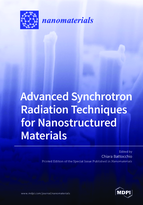Advanced Synchrotron Radiation Techniques for Nanostructured Materials
A special issue of Nanomaterials (ISSN 2079-4991).
Deadline for manuscript submissions: closed (31 March 2019) | Viewed by 32965
Special Issue Editor
Interests: XPS; NEXAFS; nanomaterials; biomaterials; surfaces and interfaces
Special Issues, Collections and Topics in MDPI journals
Special Issue Information
Dear Colleagues,
Nanostructured materials exploit physical phenomena and mechanisms that cannot be derived by simply scaling down the associated bulk structures and phenomena; furthermore, new quantum effects come into play in nanosystems. The exploitation of these emerging nanoscale interactions prompts the innovative design of nanomaterials.
Understanding the behavior of materials on all length scales, from the nanostructure up to the macroscopic response, is a critical challenge for materials science. Modern analytical technologies based on Synchrotron Radiation (SR) allow the non-destructive investigation of the chemical, electronic, and magnetic structure of materials in any environment. SR facilities have developed revolutionary new ideas and experimental set-ups to characterize nanomaterials, involving spectroscopy, diffraction, scatterings, microscopy, tomography, and all kinds of highly sophisticated combinations of such investigation techniques.
This Special Issue seeks to cover all aspects of Synchrotron Radiation applied to the investigation of chemical, electronic, and magnetic structure of nanostructured materials.
Prof. Chiara Battocchio
Guest Editor
Manuscript Submission Information
Manuscripts should be submitted online at www.mdpi.com by registering and logging in to this website. Once you are registered, click here to go to the submission form. Manuscripts can be submitted until the deadline. All submissions that pass pre-check are peer-reviewed. Accepted papers will be published continuously in the journal (as soon as accepted) and will be listed together on the special issue website. Research articles, review articles as well as short communications are invited. For planned papers, a title and short abstract (about 100 words) can be sent to the Editorial Office for announcement on this website.
Submitted manuscripts should not have been published previously, nor be under consideration for publication elsewhere (except conference proceedings papers). All manuscripts are thoroughly refereed through a single-blind peer-review process. A guide for authors and other relevant information for submission of manuscripts is available on the Instructions for Authors page. Nanomaterials is an international peer-reviewed open access semimonthly journal published by MDPI.
Please visit the Instructions for Authors page before submitting a manuscript. The Article Processing Charge (APC) for publication in this open access journal is 2900 CHF (Swiss Francs). Submitted papers should be well formatted and use good English. Authors may use MDPI's English editing service prior to publication or during author revisions.
Keywords
- Synchrotron Radiation techniques
- Synchrotron Radiation-induced spectroscopies
- X-ray absorption spectroscopy
- X-ray photoelectron spectroscopy
- X-ray diffraction
- Nanostructured materials
- Molecular structure of nanomaterials
- Magnetic structure of nanomaterials
- Electronic structure of nanomaterials







